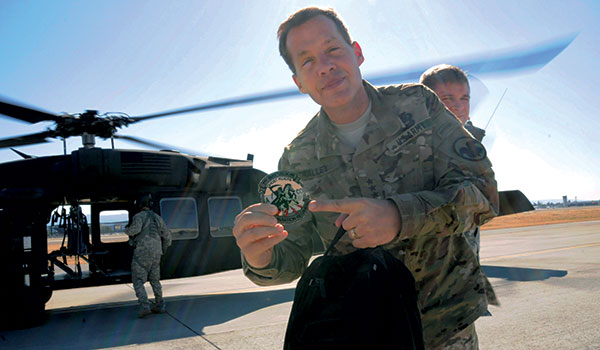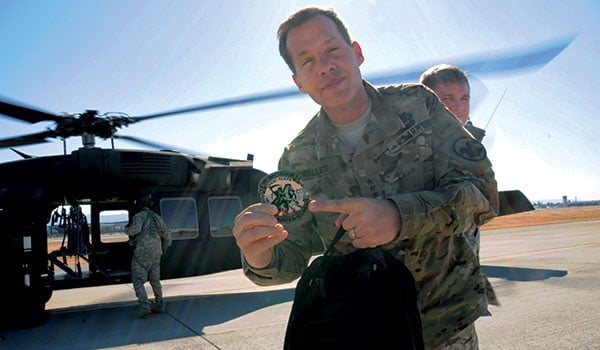
Reserve Component / By BG Scott R. Morcomb: The 11th Theater Aviation Command’s (TAC) mission carries immense responsibility, not only overseas in support of the ground component commander, but also in the United States supporting civil authorities in time of need.

LTG Jeffrey Talley, commanding general of U.S. Army Reserve Command, displays a 7th Battalion, 158th Aviation Regiment patch after exiting a UH-60 Black Hawk, during the Canada-U.S. Army Reserve Component General Officer Staff Talks (CANUSGO) in San Jose, CA, July 24. General officers of the Army Reserve, Army National Guard and Canadian Army Reserve forces are attending CANUSGO, a conference designed to promote cooperation between the land forces of each respective command. / U.S. ARMY PHOTO BY SGT HECTOR COREA, 302ND MOBILE PUBLIC AFFAIRS DET.
Much is written about the success of United States Army Reserve Aviation and its worldwide combat, humanitarian and peace-keeping missions. These well-deserved accolades have focused on the epic accomplishments the aircrews and support members achieved while continuously preparing for the next time their nation requires them to answer the call overseas. Simultaneously, the 11th is preparing for a situation which will require a response to support our fellow U.S. citizens. The 11th TAC has a 144 member permanent task force dedicated to the Command and Control Chemical, Biological, Radiological, Nuclear Response Element-A (C2CRE-A) mission, ready to respond anywhere within the United States within 96 hours.
As a component of C2CRE-A, Task Force-11 (AVN) works under the command of San Antonio, Texas based U.S. Army North (USARNORTH) and Massachusetts based Task Force-76 to provide Defense Support of Civil Authorities (DSCA). In this role, TF-11 (AVN) works in conjunction with four other task forces (Medical, Sustainment, Operations, and Signal/Special Troops Battalion) to save lives, alleviate suffering and maintain public confidence in the event of a natural or man-made disaster. These situations may include hurricanes, floods and earthquakes, as well as terrorist attacks utilizing a weapon of mass destruction. In this role, TF-11(AVN) is a self-deployable entity responsible for command and control of all Title 10 Aviation resources in a Joint Area of Operations (JOA).
In order to be mobilized, the incident must exceed the capabilities of local, state and other federal agencies, and the governor of the affected area must request assistance. The task forces will remain activated until the capacity of the incident is reduced to the point where local, state, or the lead Federal agency (LFA) no longer requires Federal military assistance. During this time of need, TF-11 (AVN) will work with other C2CRE-A and C2CRE-B elements to employ Aviation assets to help other Americans put their lives and communities back together after the disaster.
Evolving Doctrine
Leaning heavily on the lessons learned from the September 11, 2001 terrorist attacks and Hurricane Katrina (2005), the current doctrine on DSCA and Homeland Defense has evolved over the years into the modern and all-inclusive operations of today. The United States Army Reserve Aviation has been enthusiastically involved in the evolution since the beginning. Throughout the years, the 244th Aviation Brigade and 11th TAC have taken leadership roles, including participation in the Chemical, Biological, Radiological, Nuclear, Enhanced Conventional Weapons (CBRNE) Consequence Management Response Force (CCMRF) and the Defense CBRNE Response Force (DCRF), both dedicated to responding to disasters within the U.S. Since the inception of these types of organizations, USAR Aviation has been at the forefront of implementing cutting edge nuclear forensic technologies into the mission. One of the most exciting of these was the installation of the Aerial Radiation Detection Identification and Mapping Systems (ARDIMS) on a 5-159th General Support Aviation Battalion (GSAB) UH-60L Black Hawk helicopter. This system is used to measure radiation levels and find accessible locations for ground teams to collect fallout samples from a nuclear event.
Additional Training
Ensuring TF-11 (AVN) is prepared to provide aid to the American people in a time of crisis requires a great amount of additional training. All members of the Task Force must take numerous Federal Emergency Management Agency (FEMA) classes as well as higher level hazardous material (HAZMAT) and anti-terrorism courses. One of the most vital of these courses is the posse comitatus training which identifies legal boundaries inherent to military organizations conducting DSCA operations. For their two-week Extended Combat Training (ECT), USAR Aviation elements participate in Vibrant Response (VR), which has been held annually at Camp Atterbury, Indiana. This U.S. Northern Command sponsored exercise simulates the response to a nuclear attack on a major metropolitan area and improves the Task Force’s ability to work with Active Duty, National Guard and Reserve Aviation assets.
In order to serve the American public, the 11th TAC continues to stand ready to position elements in foreign countries as well as support local communities. By being ready to respond to disaster operations in the homeland, the American people know they can rely on the capabilities of USAR Aviation when they are most needed. TF-11 (AVN) is exceptionally proud of its C2CRE-A and DSCA mission and stands ready to provide relief to our fellow American citizens when called upon.
BG Scott R. Morcomb is the commanding general of the 11th Theater Aviation Command located at Fort Knox, KY.










